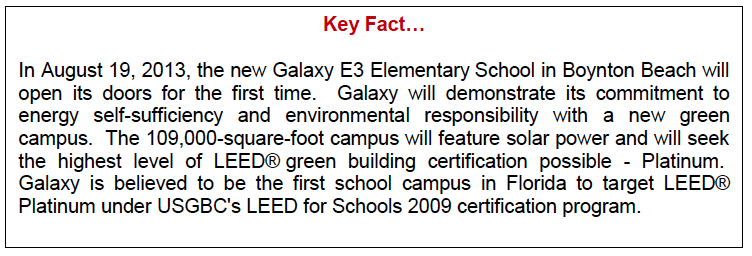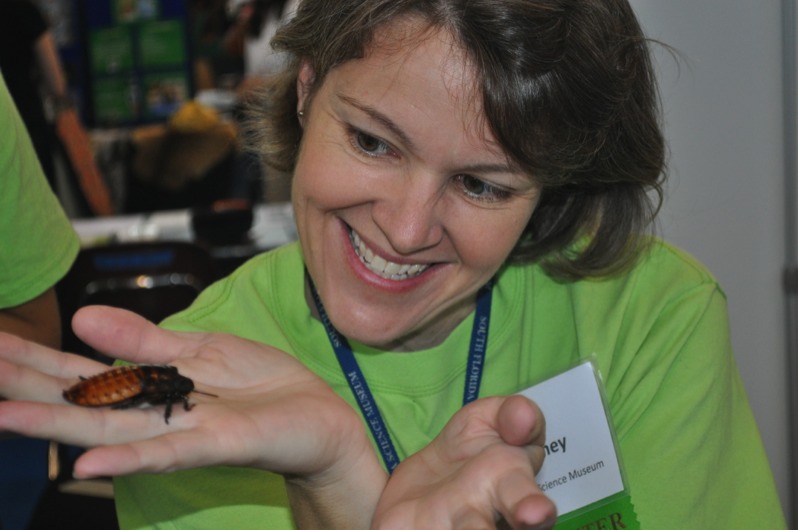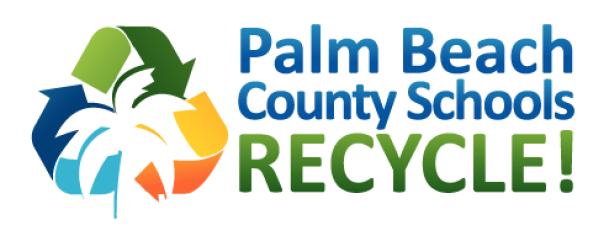

The School District takes a command role in being a good steward of the natural and built environment and is committed to the precept that conservation and resource efficiency are everyone’s responsibility. One vehicle for executing the District’s activist environmental policy is its Green Schools Initiative, involving all members of the county’s 186 schools, administration, and school communities; the initiative is led by the Division of Support Operations. The three main pillars of the Green Schools Initiative are Building Green, Learning Green, and Living Green.
The Green Schools Initiative includes activities, programs, and partnerships that build support for and underscores the need for environmental stewardship at all District levels. It also helps illustrate the important relationship between personal wellness and the health and sustainability of our one and only planet.
Many schools actively participate in green activities that engage students, staff, administration, and parents. The Growing Green School in Palm Beach County video below highlights some of the more exciting projects completed the 2012-203 school year:
The School District of Palm Beach County is a national leader in the construction and maintenance of green schools. In May 2009, as part of a policy to encourage energy and water conservation, the District added a provision stating; “The District shall plan, design, construct, operate and maintain all new District buildings to meet the Leadership in Energy and Environmental Design (LEED) Silver certification level”. Furthermore, “The District will endeavor to make all existing District buildings LEED certified based on available resources.”
Benefits of building and maintaining green schools include significant energy savings, measurable reductions in waste generation, decreased water use, and improved indoor air quality. Other benefits are less tangible and harder to demonstrate empirically, but are no less desirable. These include improvements in occupants’ health and sense of wellbeing, increased employee morale, productivity, recruitment, employee retention and improved student achievement.

Another important component of the Green Schools Initiative is to provide support for all schools in their efforts to bring sustainability concepts to the campus and the classroom. Students in a majority of the District’s schools participate in green education, either through traditional classroom curriculum or “experiential” learning outside the classroom. Some of the topics covered include energy and water efficiency, waste reduction and recycling, as well as lessons about the importance of good indoor environmental quality and healthy outdoor environments.
Another mechanism used to support this concept is the Green Schools Recognition Program (GSRP), which, in 2012, celebrated its fifth year in Palm Beach County. The program recognizes and rewards schools for taking an innovative and holistic approach to going green that includes school ground enhancement, resource conservation, curriculum connections, and community involvement with a demonstrated school wide commitment and focus on sustainability.
The GSRP is coordinated by the Florida Atlantic University’s Pine Jog Environmental Education Center in collaboration with The School District of Palm Beach County and with the support of community partners including the Solid Waste Authority of Palm Beach County, Florida Power & Light Company, Florida Department of Transportation’s SchoolPool, Audubon Society of the Everglades, The Robert Wood Johnson Foundation’s Healthy Kids, Healthy Communities Project, Bee Authentic, Growums, and the South Florida Science Museum. The program was launched in 2008 with support from the Community Foundation for Palm Beach and Martin Counties.
The top Green Schools received cash awards totaling more than $11,000 for demonstrating exceptional leadership and serving as models for the successful implementation of green school programs and practices. All cash awards are intended to help these schools continue to grow their “green” projects and build their sustainable school culture.

In addition, “Judges Choice Awards” were given to schools that demonstrate excellence in specific areas. The following schools were selected:
- default_titleAudubon Society of the Everglades awarded $500 to Jupiter Community High School for their commitment to habitat improvement and restoration.
- default_titleThe South Florida Science Museum awarded $500 to Jerry Thomas Elementary for overall excellence in greening their school curriculum.
- default_titleRobert Wood Johnson Foundation - Healthy Kids, Healthy Communities Project presented a $500 award to Greenacres Elementary for their outstanding efforts to promoting health and wellbeing within the school community.
- default_titlePine Jog Environmental Education Center presented a $500 special recognition award to each of the following schools: Palm Springs Community Middle School, Palm Beach Central High School, Royal Palm School, and Oxbridge Academy.
- default_titleFlorida Power & Light Company awarded $500 to Heritage Elementary for making great strides in energy conservation.
- default_titleSolid Waste Authority of Palm Beach County awarded $500 to Sandpiper Shores Elementary for excellence in their recycling and waste reduction programs.
- default_titleGrowums, a private company, awarded $250 to Indian Pines Elementary for their outstanding gardening initiatives.
- Show More


On October 19, 2012, the fourth annual LEARN GREEN conference was held on the campus of Alexander W. Dreyfoos School of the Arts in West Palm Beach. The conference included a one-day forum of workshops and exhibits that provide opportunities for school staff, parents, administrators, and students to learn how to “go green” at school and at home. Approximately 90 exhibitors and nearly 950 participants from the local community and representing public and private schools throughout the state of Florida attended this conference. The strong underlying message of the conference was, “You don’t need to have a green school building to build a green school!”


A final component of the Green Schools Initiative is the application and integration of sustainability concepts into the District’s daily operations. Specifically, the District works to reduce its consumption of natural resources, reduce waste generation, increase reuse and recycling rates, manage school environments to achieve healthier indoor air quality, and build institutional capacity for sustainability.
The School District currently has a very robust recycling program, which includes paper, cardboard, mixed commingled materials (plastic, glass, aluminum, and drink containers), ink and toner cartridges, electronics (“e-waste”), some food packaging, empty glue sticks, shoes and clothes, rechargeable batteries, and scrap metal. Some schools even compost organic waste onsite and use as material to fertilize their gardens. A new recycling logo was created in 2012 to assist in the branding of the District’s recycling program.

The Green School Initiative’s measureable outcomes include a reduction of its overall electrical expenses by $11 million since 2008, even as new buildings and square footage have increased. Robust recycling has resulted in the diversion of more than 700 tons of mixed plastic, glass, and aluminum and 6,000 tons of paper products from the landfill, saving over $550,000 in disposal fees. The District also collected recycling rebates of over $16,000 for electronics waste, $15,000 for paper, and almost $9,000 for ink & toner cartridges and cellular phones.
The District also operates an extensive computerized energy management system that controls school and ancillary facility mechanical and lighting systems for peak efficiency. District staff routinely inspects facilities after hours to ensure energy conservation practices are being followed.
In an effort to achieve healthier indoor air quality (IAQ) in schools, staff from the Environmental & Conservation Services (ECS) department conduct assessments and abate sources of air quality concerns. Twelve major IAQ remediation projects and more than 400 investigations were completed by ECS staff in the 2012-2013 school year. The District’s IAQ program was recently recognized by the U.S. Department of Education through their national 2013 Green Ribbon Schools award.
The District has also forged a unique partnership with the American Lung Association to combat the growing asthma epidemic among school-aged children. The “Asthma Friendly Schools” and “Open Airways” programs are two highly successful initiatives that help address this growing health threat.
ECS staff surveyed more than fifty District facilities and collected 137 radon gas samples in accordance with Federal & State rules including new schools, portable classrooms, and existing buildings that were initially surveyed and sampled five years ago.
Individual schools implemented many new sustainable practices and participated in projects that enhanced their environmental wellbeing. Among other projects, schools installed vegetable, butterfly, and hydroponic fruit gardens, instituted innovative recycling programs, created “green” curriculum connections, and engaged the greater school community in their sustainability efforts.


In 2013, the Green Schools National Network selected West Palm Beach as the host location for its 3rd annual national conference due in large measure to the School District’s national standing in the sustainability and conservation community and its deep commitment to programs and practices that provide an enriching environment for both working and learning.
The District constantly surveys the horizon for new opportunities to improve operations, while maintaining high standards for academic achievement and student engagement. The Division of Support Operation’s LEED-accredited professionals and front-line employees alike have propelled the District into the national spotlight and continue to serve as a model for other organizations interested in environmental stewardship and investing in the future.
